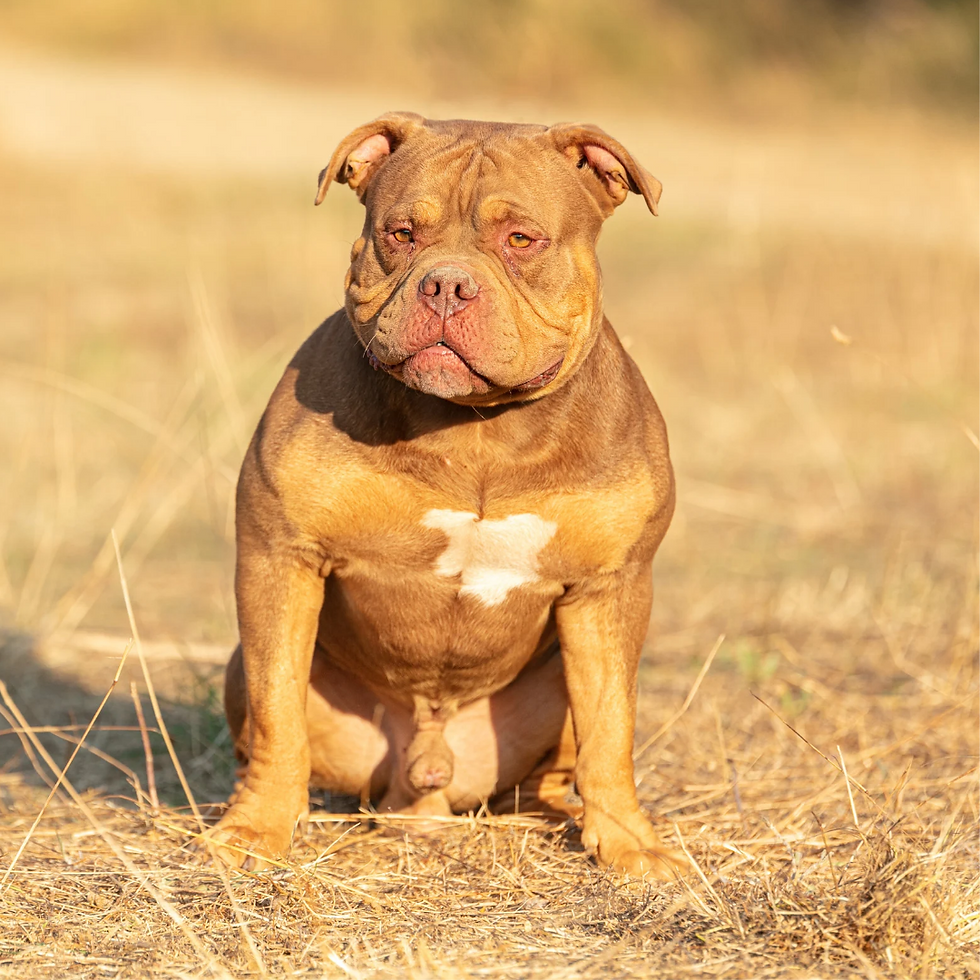The American Bully: History, Modern Day, and Reasons for Breeding
- emmaleighdean
- Jun 20
- 5 min read

Buy Hench Range Supplements HERE
The American Bully is a relatively new
breed, known for its muscular build, loyal temperament, and striking appearance. Despite its tough exterior, this breed is cherished for its gentle, family-friendly nature. In this blog, we’ll explore the history of the American Bully, its role in modern times, and the reasons behind its breeding.
The History of the American Bully
The American Bully emerged in the United States during the 1980s and 1990s, primarily as a companion breed developed from crossbreeding American Pit Bull Terriers, American Staffordshire Terriers, and other bully breeds like the English Bulldog and French Bulldog. Breeders aimed to create a dog that retained the strength and athleticism of its ancestors but with a more compact, muscular frame and a calmer, more sociable disposition.
The breed was officially recognized by the United Kennel Club (UKC) in 2013, though it had already gained popularity through the efforts of breed enthusiasts and organizations like the American Bully Kennel Club (ABKC), founded in 2004. The ABKC played a significant role in standardizing the breed and promoting it through dog shows and events. The American Bully was developed in various "types" or classes—Standard, Classic, Pocket, XL, and Extreme—each differing in size and physical traits but sharing the same core characteristics.
The breed’s creation was driven by a desire to move away from the negative stereotypes associated with Pit Bulls, often linked to dog fighting or aggression. Breeders focused on temperament, aiming for a dog that was loyal, affectionate, and suitable as a family pet while maintaining an imposing, muscular look.
Check Out Hench Range Supplements Popular With American Bullies And Bull Breeds HERE

The American Bully in Modern Times
Today, the American Bully is a global phenomenon, celebrated for its versatility and distinctive appearance. It’s a popular choice for families, dog show competitors, and even social media influencers, thanks to its photogenic qualities and friendly demeanor. The breed comes in various sizes, from the compact Pocket Bully to the massive XL Bully, catering to different preferences.
In modern times, American Bullies are often seen in urban and suburban environments, thriving as loyal companions. They’re known for their intelligence, trainability, and protective instincts, making them excellent guard dogs that are gentle with children and other pets when properly socialized. However, the breed has faced challenges, particularly in regions like the United Kingdom, where certain types (notably the XL Bully) have been banned or restricted due to concerns over public safety, fueled by isolated incidents and media portrayals. For example, in the UK, XL Bullies were added to the Dangerous Dogs Act in 2024, requiring owners to register their dogs, obtain exemptions, and comply with strict regulations.
Despite these controversies, the American Bully remains a beloved breed for many. Social media platforms like Instagram and TikTok are filled with accounts showcasing their Bully’s impressive physiques, playful personalities, and heartwarming interactions. The ABKC continues to host events worldwide, promoting responsible ownership and celebrating the breed’s diversity through conformation shows and community gatherings
Reasons for Breeding the American Bully
The American Bully was bred with specific goals in mind, and these motivations continue to drive responsible breeding practices today. Here are the primary reasons for breeding this unique dog:

Temperament and Companionship:
The foremost goal of breeding American Bullies was to create a dog with an exceptional temperament—loyal, affectionate, and gentle. Unlike their Pit Bull ancestors, which were sometimes bred for fighting, American Bullies were designed to be family-oriented companions. Breeders prioritized sociability, ensuring the dogs could integrate well into households with children, other pets, and active lifestyles.

Distinctive Appearance:
Breeders sought to craft a visually striking dog with a muscular, compact body and a smooth coat. The American Bully’s aesthetic—broad head, defined muscles, and a powerful stance—appeals to those who admire a strong, athletic look. The variety of sizes (Pocket, Standard, Classic, XL, and Extreme) allows breeders to cater to diverse preferences while maintaining the breed’s signature style.
Versatility:
American Bullies were bred to be versatile, excelling in various roles, from family pets to show dogs. Their intelligence and trainability make them suitable for obedience training, agility, and even therapy work. Breeders aimed to create a dog that could adapt to different environments, whether in a bustling city apartment or a spacious suburban home.

Reducing Stigma:
A significant motivation for breeding American Bullies was to combat the negative stereotypes surrounding Pit Bull-type dogs. By emphasizing temperament and sociability, breeders hoped to shift public perception, showcasing a dog that could be both powerful and gentle. Responsible breeding focuses on health testing and socialization to ensure the dogs are safe and well-adjusted.
Health and Longevity:
Reputable breeders prioritize the health of American Bullies, aiming to reduce genetic issues common in bully breeds, such as hip dysplasia or respiratory problems. By selectively breeding for healthier traits, they strive to produce dogs with longer lifespans (typically 8–15 years) and fewer medical issues, though challenges like joint problems or skin allergies can still arise.
BUY JOINT CARE HERE
Cultural and Competitive Appeal:
The American Bully has become a cultural icon in the dog world, with a strong presence in dog shows and pop culture. Breeders continue to refine the breed to meet ABKC and UKC standards, producing dogs that excel in conformation, muscle definition, and movement. The competitive aspect of breeding fuels innovation, with breeders striving to create the “perfect” Bully for shows or as a status symbol.

Challenges and Responsibilities of Breeding
While the American Bully’s popularity has soared, it has also led to challenges. Overbreeding and unethical practices by backyard breeders have resulted in health issues and poorly socialized dogs, which can contribute to negative perceptions. Responsible breeders emphasize health testing, proper socialization, and adherence to breed standards to maintain the American Bully’s reputation.
Additionally, potential owners must research local laws, as some regions impose restrictions on Bully breeds. Proper training and socialization are crucial to ensure these dogs remain safe and well-behaved members of society.
Conclusion
The American Bully is a testament to the power of intentional breeding, combining strength, beauty, and a loving temperament into one remarkable package. From its origins in the 1980s as a reimagined Pit Bull-type dog to its modern-day status as a global favorite, the American Bully continues to capture hearts with its loyalty and charisma. Breeding this dog is driven by a desire for companionship, aesthetic appeal, and versatility, but it comes with the responsibility to prioritize health, temperament, and ethical practices.
Whether you’re drawn to their muscular physique or their gentle nature, the American Bully is a breed that embodies the best of both worlds—a powerful protector and a devoted friend. If you’re considering adding an American Bully to your family, research reputable breeders, understand local regulations, and prepare to welcome a loyal companion who’ll steal your heart.









Comments